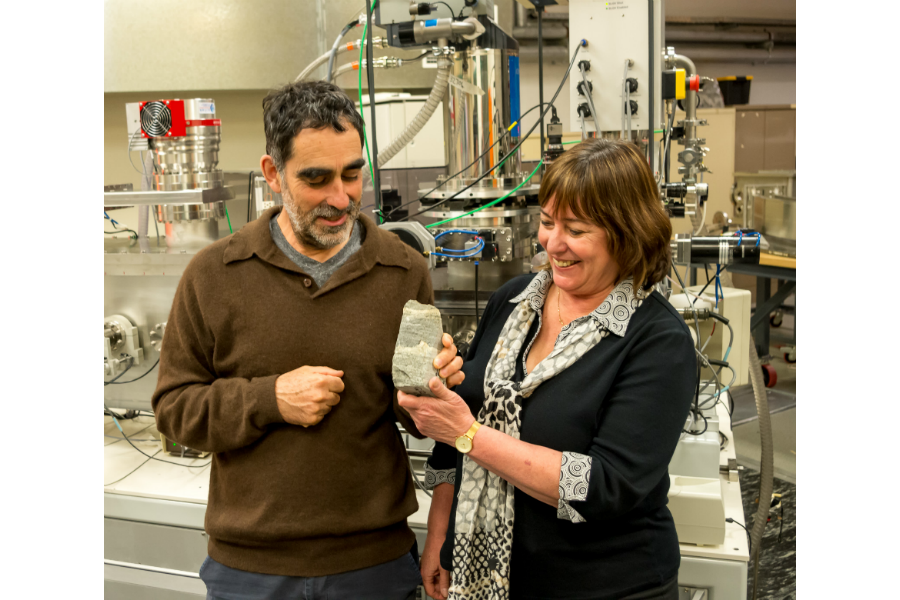Oldest fossil suggests life began quickly on a young Earth
It was just a lowly mound of slime 3.7 billion years ago. But today, this fossilized cluster of ancient bacteria is the oldest life ever found on Earth, according to a study published Wednesday in the online journal Nature. The stromatolites, discovered by a team of Australian geologists in Greenland, would date the fossil record 220 million years sooner than previously hypothesized, in an age when an embryonic Earth was being pelted by asteroids and icy comets.
“The implications are staggering,” writes Abigail Allwood, a planetary chemist and astrobiologist at NASA’s Jet Propulsion Laboratory, in a commentary that accompanies the study. “If life could find a foothold here, and leave such an imprint that vestiges exist … then life is not a fussy, reluctant and unlikely thing. Give life half an opportunity and it’ll run with it.”
If the stromatolites and their age are confirmed, these ancient bacteria could date the start of life on 4.5 billion-year-old Earth to just half a billion years later, as stromatolites are complex life forms, and likely evolved from much simpler organisms.
“If you condense the entire history of the Earth into a single calendar year, then the bacteria that created the Greenland fossils were alive in the second week of March,” writes The Atlantic’s Ed Yong. “And since they were already sophisticated, capable of forming large colonies, life itself must have arisen much earlier, perhaps sometime in mid-February.”
The fossils could also lead to a shift in our expectations about the prevalence of life in the universe, currently considered a rare anomaly, born out of perfect conditions. The hostile environment these ancient bacteria would have lived in, however, suggests life could be much more common across the cosmos, from Mars to the newly discovered nearby exoplanet, Proxima Centauri b.
"The origin of life, at least on a planet like ours, is a lot faster, and you think a lot easier than anyone had imagined. To the extent that that is true, life ought to be abundant in the universe – because there are lots of Earth-like planets out there," J. William Schopf, a pioneering paleobiologist at the University of California at Los Angeles not involved in the discovery, told The Washington Post.
These stromatolites are colonies of ancient microorganisms that grew in shallow water, according to Smithsonian Magazine. The surface of the colony trapped sediments and minerals, which eventually were incorporated into their mat-like layers. The ancient remnants of this process are recorded in the geologic record.
In 1993, Dr. Schopf reported the discovery of 3.465-billion-year-old microfossils in Western Australia, the oldest evidence of life found prior to the discovery in Greenland. If it weren’t for a series of warm summers that melted ice sheets on the world's largest island, that record might still stand.
In 2012, the team of Australian geologists sighted the rocky outcrop that contained the fossil only after large patches of snow melted in the Isua Greenstone Belt, revealing the rocks, Allen Nutman, a geologist at the University of Wollongong in Australia who led the study, told Live Science.
After they uncovered what they suspected were stromatolites, the researchers devoted four years to confirming their findings. Lab analysis established the formation is 3.7 billion years old, and showed chemical signatures consistent with the biological origin for stromatolites, Dr. Nutman told The Washington Post. They determined the age of the rock through radiometric dating, measuring the abundance of elements created by the steady decay of uranium. But not everyone in the scientific community is convinced.
As some scientists have pointed out, the microfossils were found among metamorphic rocks that have undergone high heat and heavy pressure. In other words, the fossils could be just rocks.
"They might really be biological but it's hard to absolutely refute the possibility that they formed by localized mineral precipitation from seawater," Dr. Allwood told The Washington Post. "If we found these on Mars, would we plant a flag and declare that we had found life on Mars? I think not, but we would definitely get very excited and continue looking around for more information."
Oddly enough, the study suggests that there could have been life on Mars when it was still a wet planet. If life formed this early in such hostile conditions on Earth, it could have formed on ancient Mars. And if Proxima b, whose discovery was announced last week, is found to have similar conditions to Earth, the same could be said there.





